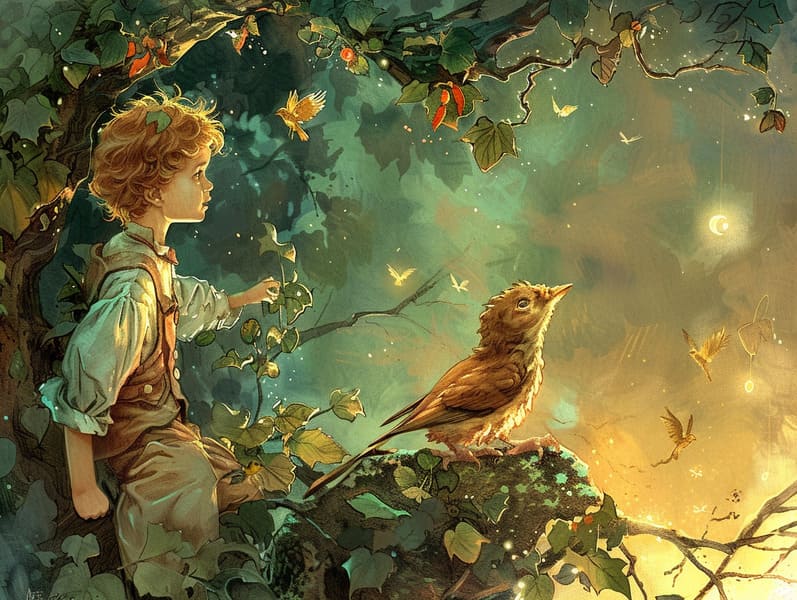Tracing the Heritage of Fairy Tales for Kids with Their Timeless Spell.
Tracing the Heritage of Fairy Tales for Kids with Their Timeless Spell.
Blog Article

Classic fairy tales have long histories. These tales have been conveyed from one generation to the next centuries before they were ever transcribed. They were born from a variety of societies, including Eastern traditions. They were initially narrated among adults, often carrying themes and messages reflective of the societal norms and beliefs of the time.
The renowned Brothers Grimm, Jacob and Wilhelm, were among the first to collect many of these beloved stories. Their volume, "Grimm's Story Collection," included narratives like "Ashenputtel," "The Bread Crumb Trail," and "Schneewittchen," which have since become essentials in the world of timeless fairy tales. Similarly, H. C. Andersen's fanciful fairy tales, such as "The Sea Maid," and "The Story of the Ugly Duckling," have touched hearts worldwide, establishing their place in the pantheon of classic fairy tales.
Despite their ancient origins, traditional fairy tales remain as important as ever, especially as children's bedtime stories. These delightful tales are now available in various formats, including richly illustrated books, whimsical animations, and online storybooks.
Their continued relevance can be attributed to several delightful features:
Valuable Lessons: Timeless fairy tales often present important moral lessons. Fairy tales like "The Boy Who Cried Wolf" teach the virtue of being truthful, while "The Hare and the Tortoise" underline the values of tenacity and humility. These stories offer little ones clear distinctions between virtue and vice, forming their moral compass in a subtle yet significant way.
Sympathy and Perception: Timeless fairy tales frequently depict heroes facing tests and troubles, inciting audiences to connect with their struggles and back their triumphs. For instance, "Beauty and the Beast" illustrates the virtue of seeing beyond the surface to comprehend the inner core of a being, encouraging sympathy and insight.
Cultural Understanding: Many traditional fairy tales are interwoven with the cultural contexts from which they grew. Immersing in these fairy tales can provide delightful insights into different backgrounds, advancing a sense of cultural awareness and understanding.
Creativity and Fantasy: The whimsical elements in traditional fairy tales—talking animals—ignite children’s inventiveness. These tales bring readers to enchanted realms, enlivening imaginative dreams and a sense of magic that persists a lifetime.
Timeless fairy tales are not only charming but also didactic. They provide captivating tools in nurturing various thinking and feeling skills in little ones. When classic fairy tales are told out loud, they boost language proficiency by offering new phrases and intricate sentence structures. This practice also cultivates listening skills and concentration, as children remain attentive, excited to see what happens next.
Furthermore, conversing about the themes and characters of traditional fairy tales can foster analytical skills and thought processes. Children are educated to find patterns, expect results, and catch on to cause and effect. These analyses also ease young readers speak out their thoughts and feelings, adding to their emotional intelligence.
In today’s cyber age, the proliferation of free fairy tales online has made these stories more attainable than ever. Web platforms and applications supply wide arrays of bedtime fairy tales that can be read or listened on anytime, anywhere. Fairy tales read out loud are particularly well-liked, giving an immersive method for the young to enjoy these fantastical tales. Read-aloud stories and narrated videos take characters and settings to life, often paired with enchanting melodies and instrumentals that improve the story adventure.
The unfading fascination of timeless fairy tales lies in their ability to transform to changing times while staying true to their core values. Contemporary reinterpretations of these tales often integrate more multicultural figures and modern settings, making them pertinent to today’s audience. However, the essential messages of spirit, sympathy, and fairness remain unchanged, continuing to touch children of all ages.
Ancient fairy tales also offer a sense of familiarity and familiarity. They make accessible a systematic narrative with a unmistakable beginning, middle, and end, often ending with the conclusion of conflicts and the triumph of goodness over badness. This dependability can be encouraging for kids, furnishing a sense of dependability in an dynamic world.
Classic fairy tales continue to mesmerize and guide new generations, maintaining their allure and fairy tales pertinence in modern society. As bedtime stories for kids, they make accessible a perfect blend of wonder and wisdom, advancing moral values, empathy, and creativity. The proliferation of digital storybooks and the widespread nature of fairy tales spoken guarantee that these ancient narratives remain accessible to new generations.
By perpetuating and circulating these stories, we continue to celebrate the rich tapestry of mythology and cultural heritage. Whether you are enjoying a vividly illustrated book, delving into a electronic collection, or listening through an voice book, the allure of traditional fairy tales is always within reach. These fairy tales demonstrate of the ageless presence of narratives and its ability to unite us across epochs and places.
Even if you are browsing a vibrantly illustrated book, delving into a digital collection, or listening via an read-aloud story, the radiance of timeless fairy tales is always within reach.
These fairy tales illustrate of the invariable essence of stories and its ability to unite us across epochs and places, casting a charm that delights and instructs alike.